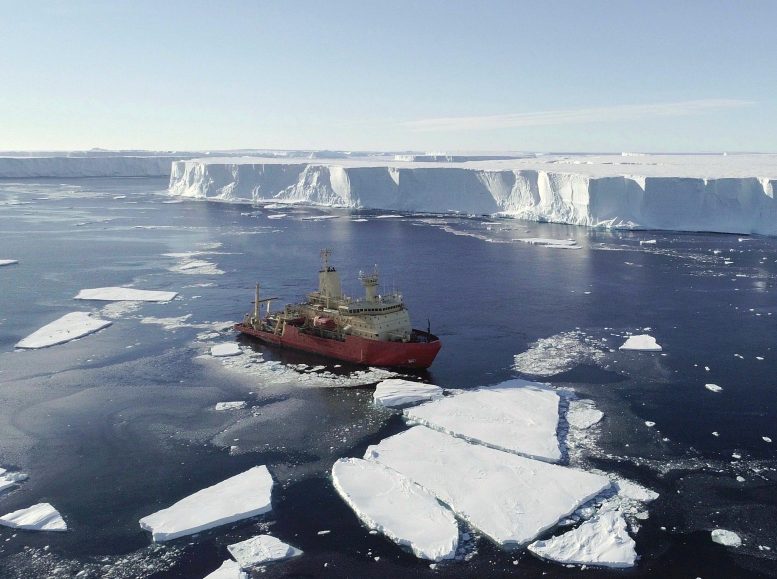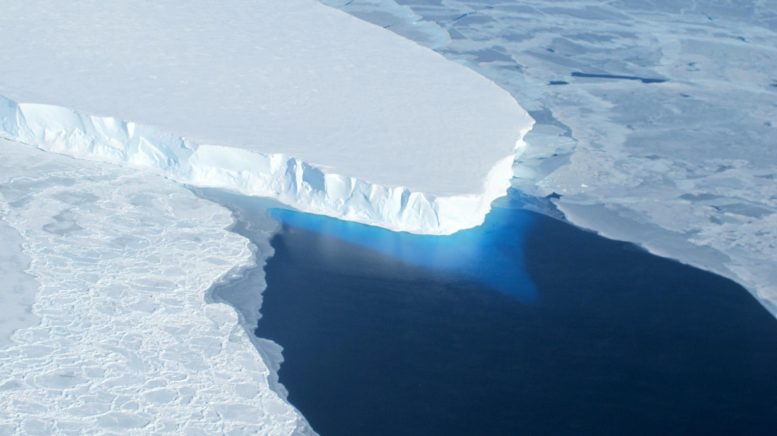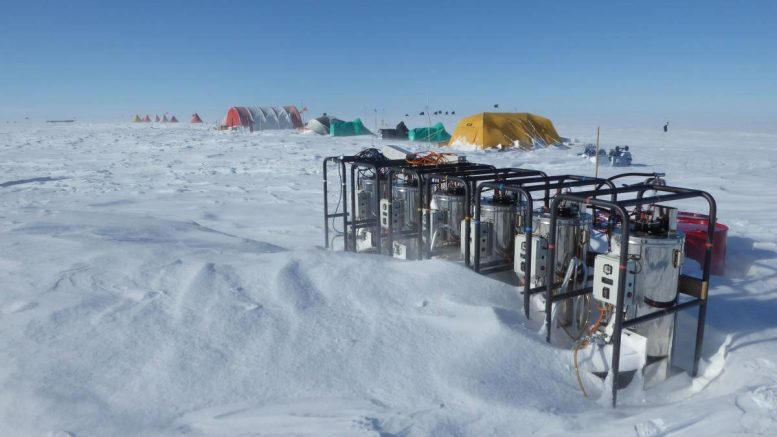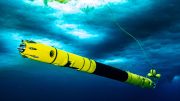
Research team surveying the seafloor near Thwaites Glacier. Credit: Alex Mazur / British Antarctic Survey
Ice sheet’s demise poses the biggest threat for sea-level rise this century.
Antarctica’s Thwaites Glacier, sometimes referred to as the Doomsday Glacier, is retreating rapidly as a warming ocean slowly erases its ice from below, leading to faster flow, more fracturing, and a threat of collapse, according to an international team of scientists. The glacier is the size of Florida or Britain and currently contributes four percent of annual global sea level rise. If it does collapse, global sea levels would rise by several feet—putting millions of people living in coastal cities in danger zones for extreme flooding.
“Thwaites is the widest glacier in the world,” said Ted Scambos, a senior research scientist at the Cooperative Institute for Research in Environmental Sciences (CIRES). “It’s doubled its outflow speed within the last 30 years, and the glacier in its entirety holds enough water to raise sea level by over two feet. And it could lead to even more sea-level rise, up to 10 feet, if it draws the surrounding glaciers with it.”
Scambos is the U.S. lead coordinator for the International Thwaites Glacier Collaboration (ITGC): a team of nearly 100 scientists funded by the U.S. National Science Foundation and U.K. Natural Environment Research Council dedicated to studying the vulnerable glacier. The five-year collaboration is aimed at collecting instrument data throughout the glacier and the adjacent ocean, and modeling ice flow and the future of the ice sheet. Their work has revealed major changes in the ice, the surrounding water, and the area where it floats off the bedrock below.

Thwaites Glacier tongue. Credit: NASA
Thwaites sits in West Antarctica, flowing across a 120km stretch of frozen coastline. A third of the glacier, along its eastern side, flows more slowly than the rest—it’s braced by a floating ice shelf, a floating extension of the glacier that is held in place by an underwater mountain. The ice shelf acts like a brace that prevents faster flow of the upstream ice. But the brace of ice slowing Thwaites won’t last for long, said Erin Petitt, an associate professor at Oregon State University.
Beneath the surface, warmer ocean water circulating beneath the floating eastern side is attacking this glacier from all angles, her team has found. This water is melting the ice directly from beneath, and as it does so, the glacier loses its grip on the underwater mountain. Massive fractures have formed and are growing as well, accelerating its demise, said Pettit. This floating extension of the Thwaites Glacier will likely survive only a few more years.

Water heaters used by Davis’ team to drill a bore hole through the ice sheet, to take measurements and deploy instruments. Credit: Peter Davis/BAS
Warm water is also a threat for the so-called “grounding zone,” the area where the glacier lifts off the seabed, said Peter Davis, a physical oceanographer at the British Antarctic Survey. Davis and his team use hot water to drill access holes from the ice shelf surface to the ocean cavity hundreds of meters below. They have found that the ocean waters in the grounding zone are warm, by polar standards, and salty, and generate prime conditions for melting the ice shelf from beneath.
Peter Washam, a research associate at Cornell University, also studies the grounding zone. His team lowered a remote-controlled underwater robot through the borehole to take measurements of the ocean, ice, and seafloor in this region. They mapped these properties up to the point where the ice and seafloor came in contact. Washam describes the grounding zone as “chaotic,” with warm water, rugged ice, and a steep, sloping bottom that allows the water to quickly melt the ice sheet from below.
But upstream of this line of floatation, the researchers have found that the water is actually pumped under the ice sheet a short distance by tides. Lizzy Clyne, an adjunct professor at Lewis and Clark College, and their team study the tidal pumping mechanism that physically forces warm water between the ice and bedrock at Thwaites. The floating portion of the glacier rises and falls with the tides—and that motion acts like a lever, pumping water under the ice sheet. Also, downstream of the grounding zone on the bottom of the floating ice shelf, constant stretching and melting is rapidly creating long channels through the ice where water can flow, impacting the long term stability of the ice shelf, said Clyne.
As Thwaites retreats upstream and into the ice sheet, it may form very tall ice cliffs at the ocean front. Anna Crawford, a postdoctoral researcher at the University of St. Andrews, and her team use computer modeling to study ice cliff failure: a process by which ice can break off the ends of the glacier into the open ocean. The process can take on many forms, but all of them could lead to very rapid retreat of the massive glacier. The bedrock shape of West Antarctica makes the region vulnerable to rapid retreat via ice-cliff failure, as increasingly tall cliffs could be exposed as the ice retreats. This could lead to a chain-reaction of fracturing, resulting in collapse, said Crawford. A challenge for the team is assessing if, when, and how fast this might occur, but major ice loss is possible within several decades to a few centuries.
“If Thwaites were to collapse, it would drag most of West Antarctica’s ice with it,” said Scambos. “So it’s critical to get a clearer picture of how the glacier will behave over the next 100 years.” ITCG research, including future sea-level projections, will be vital for policymakers in their efforts to mitigate and adapt to the impacts of global sea level rise, the team said.
This work was presented at the AGU Fall Meeting during a press conference on December 13.









CATASTROPHIC! Absolutely Unthinkable! Perhaps WE should have listened to those “Nervous Nelly Naysayers” 30+ years ago. MAYBE by now WE (as in: the WORLD) might have a plan in-place that didn’t involve leaving 1/3+ of the Human population behind to drown, while those with the MEANS head for higher ground. As EVER, Mother Nature has the FIRST and FINAL word. It is past listening to the First. Those WORDS-UP whispered through the Ecosystem in the 1800s. As to FINAL words: It might well be late in the Day but… Where there is a WILL there’s a WAY. But we’ll have to get the LARD out of our butts and, more importantly: get the LARD out from between our ears.
WHAT’S THAT I HEAR!? Is that the CRACK OF DOOM or “only” the ICE? Either way, it’s TIME to LISTEN.
💬*
🐧
*[One way or another, I’ll be seein’ yur… One and raise you ten. Don’t bet the FARM on the turn of a card.]
Interesting View.
The Glaciers are one of the large source of Fresh Waters on the planet. Fresh Water Resources are in demand in many parts of the world where there are water shortages.
Global warming could result in a disaster as described above.
HOWEVER, Risk and Opportunity exists simultaneuosly.
Opportunity ?
Huge Floating Chunk of Glaciers can be transported to the Water Resource dificient parts of the world by towing the same using Solar Powered tugs! Seems far fetched. However as Fresh water Resources become Scarce Globally , people and nations will be willing to pay for the same. Today water may be free.In the future ,it may be a important resource which people will be willing to pay for. Artificial Lakes built inland can be fed using such Glaciers. Reimagine a Risk to turn it into an Opportunity. The rest will follow.
Views expressed are personal and not binding on anyone.
In addition to the earlier comments some more thoughts for consideration are being shared.
1. We have Three Poles where Sizable Glaciers have been formed. The North Pole, The South Pole and the Himalayan Range. These Glaciers were not melting as rapidly prior to our increased industrial activities, which helped to warm the Climate and cause disruption in the weather patterns. The Causeattributed to Carbon alone may betrue . Carbon is black and black absorbs heat . White reflects light.So ensuring Dlaciers beeing tugged to water shoratage locatons should be covered with White to reflect the suns racys.
2. The Glaciers were the Source of the Water flowing into the Rivers . It starts as a trickle at the Source of the Glacier, and as the water droplets coalesce they became a trickle and then stream as they flowed down the mountain and fed the Rivers, which became Giant Rivers feeding the Rivers which meander along and finally flow into the Seas and Oceans where they merge and become one with the Great Oceans .
3. These are the Glacier fed Water Bodies and all Civilizations have flourished around the banks of such Rivers especially in the Asian Continent which is home to the Unipolar Himalayan Glaciers. The Two nations with the largest populations in the globe are China and India. They are both fed by the Himaliyant Glaciers. Both the Indian and Chinese side gets the mighty Brahmaputra (Son of Brahma) benefits . This River which is called Yang Tse Kiang or Yellow River or the river of sorrow on the Chinese Side had caused lots of sorrow in thepast thanks to the uncontrlled flow. India is also blessed with many other mighty rvers Like Ganges (Ganga) and its tributaries AND Jamuna (Which has been polluted beyond belief) and is like a black sewer running close to the capital of India (Delhi / New Delhi).
4. The other major Source of Water for drinking and agricultural purposes are the monsoons which have become unreliable in a era of Climate Change . In Light of this, we need to we need to rethink and reimagine the source of supply of these Water Sources and Water Bodies and how best to delver the water needs to meet the needs of the Global Population.
5. In the Terry School of Buisness we were taught to set BHAG when we set targets. BHAG stands for BIG HARY AuDACIOUS GOALS . HERE are some , which can be considered by the engineering and technology experts.
(a) Replenishing and rebuiding the Glaciers which are meting rapidly. I suspect this is a doable task . We live on land. We breahe Air from the Atmosphere. Above it is the Stratosphere ….. till we reach Space. As we go higher it gets colder …
(b) I remember reading about a scheme to create a Lift which will transport us into the Space. (c) Now if we build a Lift large enough and a piping system to transport Sea Water into the Colder Temperatures and release the same as aq vapourized stream of Water in the Colder Climates in the Stratosphere , it will freeze and provide ice and as it descends into the atmosphere it will start melting and provide rain in the non polar regions. In the Polar Region it will likely bee sleet and ice and replenish the Glaciers. Artic and Antartic can be restored to their pristine Glory. All the Flora , Fauna , Penguins and PolarBears will thank us for returning their homes to them.
Views expressed are personal and not binding on anyone.
In a shorter segment of time, the earth’s atmosphere is being destroyed by sattelite and exploration launches, while oceans are being irreparably damaged by the trillions of gallons of sewage and toxic chemicals pumped in on a yearly basis.
Please stop using Thwaites and PIG as evidence of global warming. We’ve known since the 40s that there are active volcanic fields under and near both. Why use such easily disproven examples? We are trying to convince are we not?
Ecclesiastes 1:7-8 “All streams flow into the sea, yet the sea is never full. To the place the streams come from there they return again.”
With all due respect, please leave things alone, God’s plan is still perfect and needs no “HELP” from us.
Sounds like another failed prediction by the end of the world over lords your last grant money is running low.
“Replenishing and rebuiding the Glaciers which are meting rapidly.”
The climate is always changing! If it were to suddenly start cooling, then there would be less melting of the glaciers, and there would be reduced flow of the rivers fed by them. Either way, a large population that has become dependent on the current discharge volumes, will be in trouble with warming OR cooling!
How many people know that the sea water warming that is melting this ice shield is most likely a volcano, not global swarming.